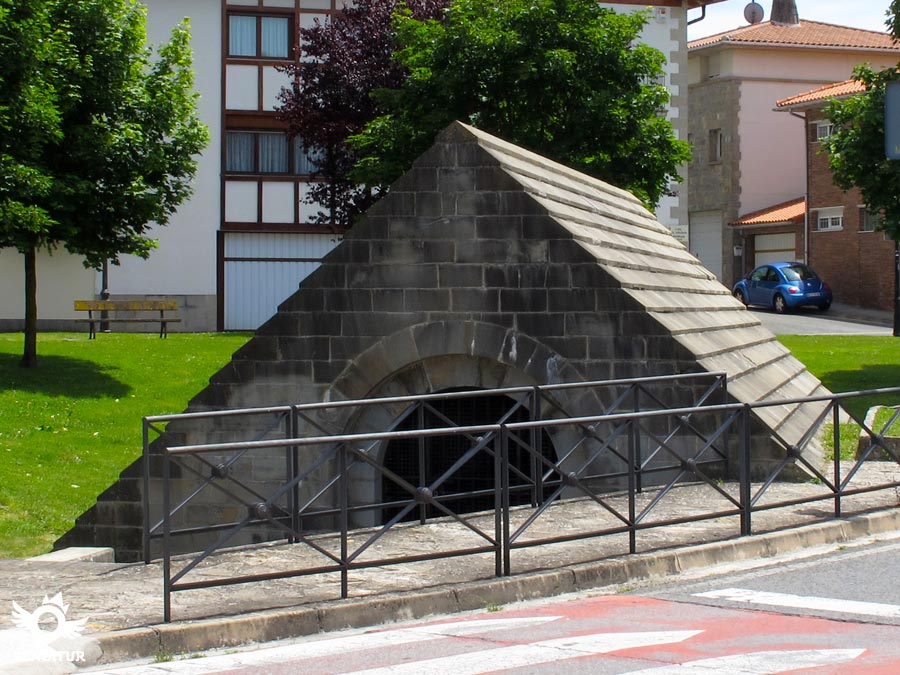It is located southwest of Pamplona-Iruña between the rivers Arga and Elorz and the mountains of the peña de Etxauri and Alto del Perdón. Its landscape, seen from any nearby summit, and depending on the agricultural season in which we find ourselves, varies from the browns and ochres of autumn, to the spring greens, and from the yellows of summer to the whites of winter days.

In the past, it was the passage of pilgrims from Santiago de Compostela along the Pamplona-Estella inland route, where they found an establishment that welcomed them. But little is known about its history, which dates back to the first third of the 12th century. From the end of that century it was the seat of one of the encomiendas of the Hospitalarios de San Juan de Jerusalén in Navarre, who owned most of the district and the church from the 13th century onwards. In 1421, the king financially helped the people to repair their church.
The parish church of Saints Emeterio and Celedonio is in Romanesque style from the 11th century. Over time it has undergone transformations, such as the tower that looks like it dates back to the 17th century. The façade is Romanesque, very simple, with a semicircular arch and a chrismon at the tympanum.

The church of San Miguel Arcángel was part of a San Juan monastery that had a pilgrims' hostel. The order of the Hospitallers was abandoned following the disentailment of Mendizábal in 1836. In 1989, the Government of Navarre restored the church and what remained of the old monastery buildings and ceded it again to the Sovereign Military Order of Saint John of Jerusalem of Rhodes and Malta in 1998. Today it continues its hospital work, begun eight centuries ago, maintaining a hostel for pilgrims in a building adjacent to the medieval church. Towards the exit of the village we can see an original medieval fountain. In the town centre, the Echeberría house stands out, which has been somewhat modernly modified. The main body dates from 1777 and was made of ashlar stone. Another interesting example of an old house is that of Nonecua, which has an interior complex and whose façade has recently been built in the traditional way.

The 4th, 5th, 6th and 7th of September are the Cizur Menor-Zizur Txiquia festivities in honour of the Nativity of the Virgin and the 9th of June. It is celebrated the day of the Cendea, every year it is done in one of the different councils that form it.
In the house number 1 of the street of San Emeterio was the Hospital de Nuestra Señora del Perdón, property of the Cofradía del Apostolado o de Ánimas, which was kept of alms. When Cizur Menor-Zizur Txiquia ceased to be a passageway for pilgrims, the building became the Hospital de Enfermos, and when the latter were transferred to Pamplona-Iruña in 1817, the council of Cizur acquired it together with the estate called "Hospitalecoa" to support the poor and foundlings of Cizur and Guenduláin.
Cizur Menor-Zizur Txikia has access from the A12, Autovía del Camino, which links Pamplona-Iruña with Logroño at the same level as the neighbouring Cizur Mayor-Zizur Nagusia. There is also the NA-600, which comes directly from Pamplona-Iruña on one side and connects it with the AP-15 and the N-121 in Campanas, passing through Esparza-Espartza and Arlegui on the other.
There is a regular bus service that covers the route Pamplona/Iruña-Cizur Menor/Zizur Txikia throughout the year. There is also urban transport from Pamplona-Iruña.
SENDITUR is not responsible for any variation in the information described, as well as for the misuse of its guides and recommends that everyone be responsible and prudent in carrying out the activity. Likewise, we invite you to document yourself with books and specialized guides to complement the information described. From the commitment of SENDITUR with Nature and the respect to the balance of the environment, SENDITUR urges you to travel in a responsible way, with low environmental impact and respecting at all times the Natural, Cultural and Social environment wherever you go. For any suggestion, SENDITUR invites you to send an email to .
Continue watching …